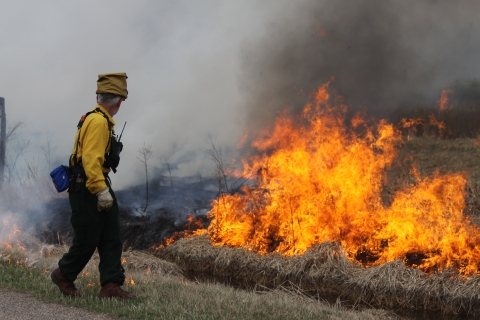What We Do
The National Wildlife Refuge System is a series of lands and waters owned and managed by the U.S. Fish and Wildlife Service. Wildlife conservation is at the heart of the refuge system. It drives everything we do from the purpose a refuge is established, to the recreational activities offered there, to the resource management tools we use. Selecting the right tools helps us ensure the survival of local plants and animals and helps fulfill the purpose of the refuge.
Deciding what tools to use and at what time of the year can be a complex undertaking. Through sound science and adaptive management, we are able to look at the habitat requirement of our priority species of concern and time the use of different habitat management tools to create the best habitat outcome for a particular species. The fascinating process also then benefits a cascade of other refuge wildlife that have similar habitat needs.
Species of concern that help focus our work and which tool we use include the Karner blue butterfly, Blanding’s turtle, American Bittern, American woodcock, blue-winged warbler, bobolink, brown thrasher, eastern whip-poor-will, golden-winged warbler, least bittern, red-headed woodpecker, sedge wren, trumpeter swan, wood thrush, whooping crane, upland sandpiper, black tern, bald eagle, gray wolf and northern long-eared bat.
Continued biological inventory and monitoring also help us gather long term data which help direct how we manage these and other species. Refuge staff and student research continue to push our understanding of many species and their needs on the refuge and beyond. Research yields knowledge that helps us continue to adapt to changes in the environment, while better understanding the needs and tolerances of wildlife.
Monitoring specific species of concern and research on the refuge drive our habitat management decisions. We use various management tools to do this, including water level management, moist soil management, prescribed fire, timber harvest, mechanical brush removal and mowing. We also work to control invasive species invasive species
An invasive species is any plant or animal that has spread or been introduced into a new area where they are, or could, cause harm to the environment, economy, or human, animal, or plant health. Their unwelcome presence can destroy ecosystems and cost millions of dollars.
Learn more about invasive species and care for human-made structures that help control water flow through the refuge. This is a team effort - from our land managers and biologists to our maintenance and facilities professionals.
Management and Conservation
Refuges use a wide range of land management tools based on the best science available. Some refuges use prescribed fires to mimic natural fires that would have cleared old vegetation from the land helping native plants regenerate and local wildlife to thrive. Other refuges contain wilderness areas where land is largely managed in passively. The management tools used are aimed at ensuring a balanced conservation approach where both wildlife and people will benefit. At this field station our conservation toolbox includes:
- Water level management
- Moist soil management
- Prescribed fire
- Timber harvest
- Mechanical brush removal
- Mowing
Law Enforcement
U.S. Fish and Wildlife Service law enforcement officers have a wide variety of duties and responsibilities. Officers help visitors understand and obey wildlife protection laws. They work closely with state and local government offices to enforce federal, state and refuge hunting regulations that protect migratory birds and other game species from illegal take and preserve legitimate hunting opportunities.
Laws and Regulations
Know the unique rules of each refuge before you visit. Different locations have sensitive flora, fauna and various wildlife needs that can change by season. Be aware and follow these rules to ensure continuous public enjoyment of the refuge.
“Take nothing but memories, leave nothing but footprints.” - Chief Seattle

